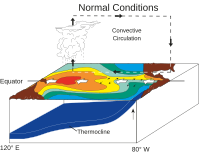
Photo from wikipedia
Based on an analysis of hindcasts from a seasonal forecast system, complemented by the analysis of a large ensemble of AMIP simulations, possible causes for skillful prediction of the winter… Click to show full abstract
Based on an analysis of hindcasts from a seasonal forecast system, complemented by the analysis of a large ensemble of AMIP simulations, possible causes for skillful prediction of the winter Arctic Oscillation (AO) on a seasonal time-scale are analyzed. The possibility that the recent increase in AO skill could be due to model improvements, or due to changes in the persistence characteristics of the AO, is first discounted. The analysis then focuses on exploring the possibility that the recent increase in prediction skill in AO may be due to sampling variations or could have physical causes. Temporal variations in AO skill due entirely to sampling alone cannot be discounted as this is a fundamental constraint on verifications over a short time-series. This notion is supported from theoretical considerations, and from the analysis of the temporal variations in the perfect model skill where substantial variations in skill due to sampling alone are documented. As for the physical causes, the analysis indicates possible links in the prediction skill of AO with the SST forcing from the tropics, particularly related to the SST variations associated with the Trans-Niño Index (TNI). Interannual and low frequency variations in the TNI could have contributed to similar temporal variations in AO skill. For example, a dominance of central Pacific El Niño events after 2000 (a reflection of low-frequency variations in TNI) coincided with an increase in the prediction skill of AO. The analysis approach and results provide an avenue for further investigations; for example, model simulations forced with the SST pattern associated with the TNI, to establish or reaffirm causes for AO skill.
Journal Title: Climate Dynamics
Year Published: 2017
Link to full text (if available)
Share on Social Media: Sign Up to like & get
recommendations!